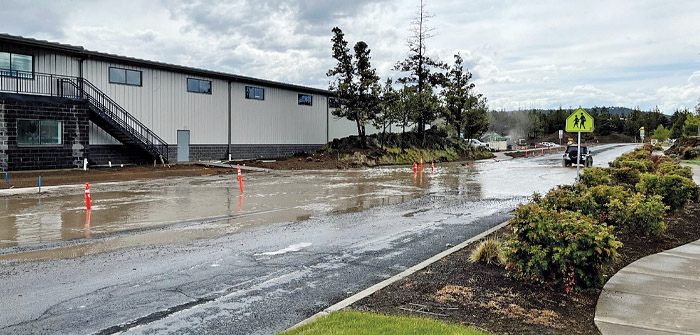(Runoff from new construction overwhelmed existing stormwater drywells, creating a temporary pond | Photo courtesy of Wallace Group, Inc.)
Public and private infrastructure have largely withered in the face of decades of neglect and under-funded repairs, and now, changing climate. Even modest rainfall events in central Oregon over the past few months have caused numerous roads to flood after stormwater systems are overwhelmed. As the ambient air temperatures rise, so too does its capacity hold more moisture and increase the potential for flooding.
Central Oregon is located in the rain shadow of the Cascade Range and typically receives less than 12-inches of precipitation each year. Despite the relatively dry high desert environment, central Oregon cities experience high intensity precipitation and rapid snow melt events that do cause flooding.
Stormwater management provisions are prescribed in local building codes and mandate that stormwater generated on private property must be treated and disposed of on the same property. For public property, there are no municipal stormwater collection and disposal systems in central Oregon. Instead, parking lots, hard surface areas and streets collect runoff to catch basins and transmit the water to swales or drywells. You can think of swales as dry ponds that hold water temporarily until it percolates into the ground. Drywells on the other hand are large open holes in the soil and rock that are around 15-feet in diameter and 15-feet deep. While you can’t see drywells from the surface, they are located throughout central Oregon where manholes are seen in streets and parking lots. Like swales, stormwater can be collected in drywells until it percolates down through the soil and rock.
Local geology contributes to how well a given property will drain stormwater. In general, basalt bedrock drains well because it is typically fractured and jointed which more readily transmits excess stormwater. What can become problematic over time is when small soil particles build up in drywells and plug the drainage pathway. Drywells need to be maintained to clear debris.
What are local engineers doing to help address stormwater runoff amid erratic weather patterns and limited stormwater infrastructure?
At the Wallace Group, we are advocates of performing infiltration testing on soil and rock so an economical stormwater management plan can be developed. All too often we see large portions of properties devoted to swales that never fill up, or where drywells cannot accommodate the stormwater runoff and over-flow. Not only is flooding a nuisance, but it also can often be found in crawl spaces leading to mold growth. We have found that using appropriate infiltration rates for soil in swales and another rate for infiltration through fractured basalt in drywells can help developers ensure that stormwater facilities are designed to accommodate the actual runoff, with a margin of safety for even more erratic and high intensity precipitation events.





